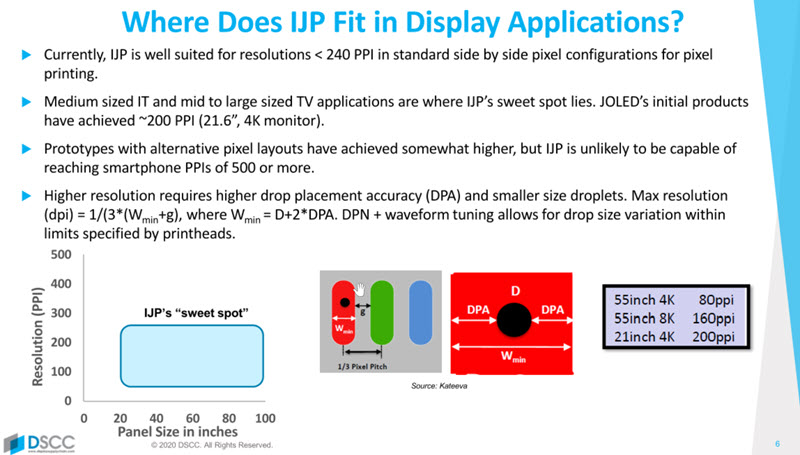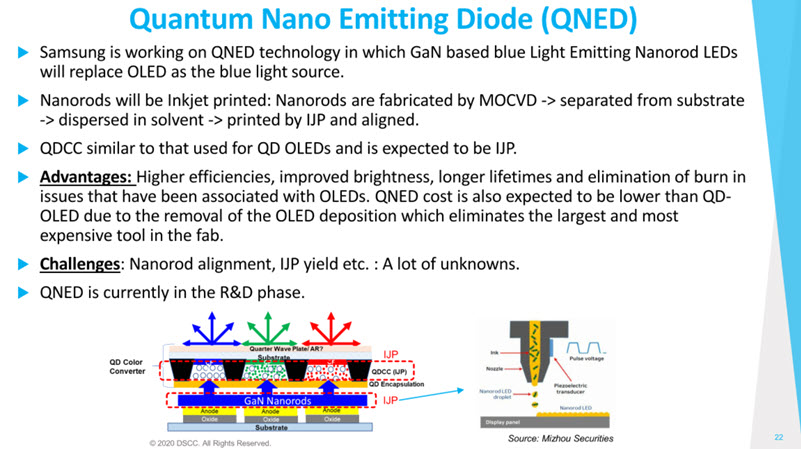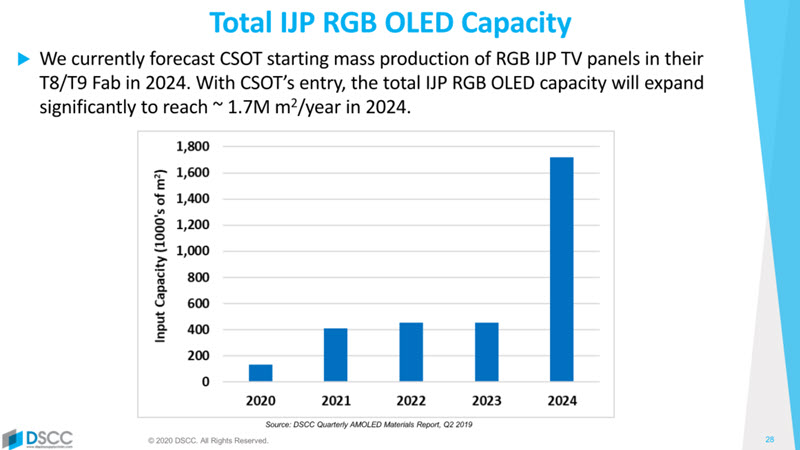I have been lucky enough to have attended all of the SID Display Week Business Conferences and it’s always really useful and informative. This year there were over 40 speakers (wish I’d known that before I agreed to report it for someone!) and the conference is “the gift that keeps giving” as it will be online for some months. It’s a real bargain buy in information. Today I’m going to report Sid Mohan’s talk on Ink-Jet Printing in displays.

 I’ve been reporting on ink-jet printing for around 20 years and as I mentioned a couple of years ago (Is MicroDisplay on the Last 20%?) in 2003, at a conference that Meko (the publisher of Display Daily) ran, David Fyfe, then of Cambridge Display Technology, reported that CDT was working with Epson and Litrex and was “very close to a breakthrough” in ink jet printing (IJP) of OLED displays. As Mohan said, there are products being produced now, but only just!
I’ve been reporting on ink-jet printing for around 20 years and as I mentioned a couple of years ago (Is MicroDisplay on the Last 20%?) in 2003, at a conference that Meko (the publisher of Display Daily) ran, David Fyfe, then of Cambridge Display Technology, reported that CDT was working with Epson and Litrex and was “very close to a breakthrough” in ink jet printing (IJP) of OLED displays. As Mohan said, there are products being produced now, but only just!
Mohan is Director of Display Research at DSCC. Before joining DSCC in February 2020, he he led the R&D work on ink jet printing (IJP) of quantum dots for color conversion applications at Kateeva, so he is an expert in this field. His talk covered:
- IJP in Advanced Displays
- IJP of RGB OLEDs
- IJP of Quantum Dots (QDs)
- Outlook for IJP
- Summary
IJP OLED layers are in many OLEDs and pretty well all flexible and foldable OLEDs as organic TFE layers, but they are blanket coatings, rather than fine details or pixels. There is a lot of interest now in printing of QDs whether QD OLEDs, QNEDs and EL-QDs as well as RGB OLEDs.
IJP is suitable for <240ppi but medium-sized and large TV applications are the IJP sweet spot. JOLED has products at 200ppi for UltraHD on a 21.6″ monitor panel. However a 55″ 8K TV is just 120ppi, so that’s a clear target application. Although prototypes have been made that can go to higher ppi, the very high ppis demanded in smartphones are unlikely to be a good market for IJP.
IJP for RGB OLEDs
IJP for RGB OLEDs is being developed and the HIL, HTL and EML layers can be deposited by inkjet into wells and dried and baked before receiving further layers. Common layers such as ETL, EIL and Cathode layers can be deposited by vacuum thermal evaporation (VTE).
Why use IJP? RGB OLEDs have been difficult to scale up beyond 1/2 6G using FMM methods, so have been uneconomic for TV applications. However, IJP can scale to Gen 8, with several equipment makers able to do this.
IJP allows much better material utilisation at around 85% compared to just 10% to 15% for VTE with FMM and 25%-40% for open mask VTE. It can also be used for top emission architectures, which can have substantially fewer layers, potentially without filters.
Why hasn’t it been widely commercialised? As long ago as 2009, Panasonic and Sumitomo planned in 2009 to make TVs in 2010. Mohan said that one of the main challenges is the elimination of mura whether
- Line mura from missing or low volume nozzles
- Swath mura from inconsistent volume at step width
- pixel to pixel non-uniformity from uneven drying or non-flat films etc
- Colour mixing from bad directionality of jetting or inaccuracies in placement etc
Various strategies have been tried, but high yield has been really difficult to achieve. Further it has been hard to get the right efficiency, lifetime and colour all at the same time for the soluble materials needed, whether small molecule-based (LG Chem, Merck, Mitsubishi) or polymer-based (Sumitomo).
IJP Materials Are Tricky
IJP materials have extra requirements for the delivery process beyond the basic optical properties and that complicates things. And, of course, there is competition and the vacuum deposition target materials keep improving. As in other OLEDs, blue is difficult to create with a long lifetime and the right colour. A filter needs to be used to get a wide gamut with JOLED/Sumitomo’s approach and that reduces light output by 40% and adds reflectivity. Switching from a filter to a circular polariser and micro-cavity method makes light output even worse, but helps with reflectivity.
Currently, only JOLED is making commercial products based on IJP OLED and that is being used by Asus and Eizo to make monitors. However, the Asus monitor is nearly $4K and Amazon in the US has only three in stock. However, if money is no object, it’s a great monitor!
IJP for QDs
Turning to QD displays, QD OLED is a candidate technology with top emission from a blue OLED source with red and green coming from colour conversion by QDs. The QDs can be deposited by IJP and the first generation of QD OLEDs are expected to have secondary colour filters to reduce blue light leakage.
There are challenges in getting good long life blue and DSCC thinks that Samsung may have three blue layers.
Making the QD conversion layers with IJP has advantages as it may be simpler, with only one layer, and you only deposit on two colours. The materials can be solvent-free and the thickness can be in micrometres, rather than the nanometres used for OLED layers. However, clogging of printheads can be a major challenge as the nano-particles need to be well dispersed. Further, the ink formulations need to be further refined to get the optimum balance between optical requirements and the optimal viscosity for IJP.
Mohan said that he believes that Samsung’s approach will use solvent-free QDs. The firm has installed Kateeva and Semes IJP tools for its pilot lines and also believes that Semes has won the order for mass production machines, partly because Samsung wants to support Korean companies.
QNED May be Coming
Turning to QNED, which is similar to QD OLED technology, but uses GaN-based blue nanorod LEDs replace the QD layer (Are Quantum Nano Emitting Diodes (QNEDs) the Next Big Thing?). The LEDs can be placed using IJP after manufacture using MOCVD. QNED should have higher brightness, longer lifetimes and elimination of burn-in compared to OLEDs and may be cheaper to make as there is no need for OLED deposition, which needs very expensive machinery. However, the technology is still in the R&D phase and there are many unknowns, including the efficiency of the Nanorod LEDs and how you align the nanorods (they need to be lined up to work the way you want).
EL-QDs (electrically stimulated QDs) are the ulimitate goal of QD-based displays. In theory, all the layers can be deposited by IJP. The EL-QDs can be driven at high current densities for high brightness (although that will impact lifetime). They can have lower power consumption and wider gamuts because of the narrow FWHM. Materials should also be lower cost than OLEDs.
However, cadmium-free EL QD materials are still not as good as those of Cd-based dots. Blue EL-QDs still have a short lifetime (they are still two orders of magnitude below those of OLEDs, Mohan said(. There will still be the yield challenges for IJP that will be similar to those for IJP OLEDs.
Unlike OLEDs, QDs are colloids and can only be deposited using a solution processing technique. There are also only four layers, the HIL, HTL, EML and ETL layers.
Looking at the status of RGB IJP printing now, there is some ramping up of IJP mass production by JOLED, which should have a capacity of 20K sheets/month in G5.5 eventually.
CSOT/TCL has invested $187 million in JOLED to use its technology for TVs and DSCC is currently forecasting that CSOT will have mass production at Gen 8.5 in Guangzhou by 2024 with around 20K sheets/month in phase one and another 20K in Phase 2.
Other companies are still involved in R&D for IJP OLED.
Mohan then summarised the developments for QD OLED. The firm plans to convert its T8-1 G8.5 LCD line for QD OLED, which would reduce the capacity from 120K LCD sheets per month to 30K per month of QD OLED because of the increased number of steps.
The outlook for QNED and EL-QD is less clear and will depend on pilots. EL-QD is unlikely to be in mass production before 2025.
In summary, these new technologies offer good opportunities for IJP. (BR)




